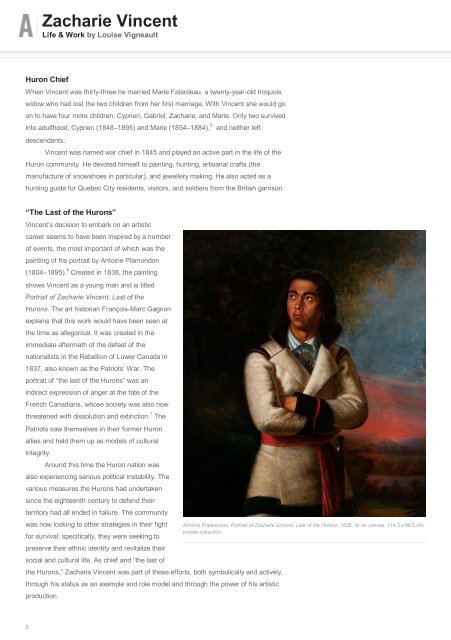Zacharie Vincent
Art-Canada-Institute_Zacharie-Vincent
Art-Canada-Institute_Zacharie-Vincent
- No tags were found...
You also want an ePaper? Increase the reach of your titles
YUMPU automatically turns print PDFs into web optimized ePapers that Google loves.
<strong>Zacharie</strong> <strong>Vincent</strong><br />
Life & Work by Louise Vigneault<br />
Huron Chief<br />
When <strong>Vincent</strong> was thirty-three he married Marie Falardeau, a twenty-year-old Iroquois<br />
widow who had lost the two children from her first marriage. With <strong>Vincent</strong> she would go<br />
on to have four more children: Cyprien, Gabriel, <strong>Zacharie</strong>, and Marie. Only two survived<br />
into adulthood, Cyprien (1848–1895) and Marie (1854–1884), and neither left<br />
descendants.<br />
<strong>Vincent</strong> was named war chief in 1845 and played an active part in the life of the<br />
Huron community. He devoted himself to painting, hunting, artisanal crafts (the<br />
manufacture of snowshoes in particular), and jewellery making. He also acted as a<br />
hunting guide for Quebec City residents, visitors, and soldiers from the British garrison.<br />
5<br />
“The Last of the Hurons”<br />
<strong>Vincent</strong>’s decision to embark on an artistic<br />
career seems to have been inspired by a number<br />
of events, the most important of which was the<br />
painting of his portrait by Antoine Plamondon<br />
(1804–1895). Created in 1838, the painting<br />
shows <strong>Vincent</strong> as a young man and is titled<br />
Portrait of <strong>Zacharie</strong> <strong>Vincent</strong>, Last of the<br />
Hurons. The art historian François-Marc Gagnon<br />
explains that this work would have been seen at<br />
the time as allegorical. It was created in the<br />
immediate aftermath of the defeat of the<br />
nationalists in the Rebellion of Lower Canada in<br />
1837, also known as the Patriots’ War. The<br />
portrait of “the last of the Hurons” was an<br />
indirect expression of anger at the fate of the<br />
French Canadians, whose society was also now<br />
threatened with dissolution and extinction. The<br />
Patriots saw themselves in their former Huron<br />
allies and held them up as models of cultural<br />
integrity.<br />
Around this time the Huron nation was<br />
also experiencing serious political instability. The<br />
various measures the Hurons had undertaken<br />
since the eighteenth century to defend their<br />
territory had all ended in failure. The community<br />
was now looking to other strategies in their fight<br />
for survival: specifically, they were seeking to<br />
preserve their ethnic identity and revitalize their<br />
social and cultural life. As chief and “the last of<br />
the Hurons,” <strong>Zacharie</strong> <strong>Vincent</strong> was part of these efforts, both symbolically and actively,<br />
through his status as an example and role model and through the power of his artistic<br />
production.<br />
6<br />
7<br />
Antoine Plamondon, Portrait of <strong>Zacharie</strong> <strong>Vincent</strong>, Last of the Hurons, 1838, oil on canvas, 114.3 x 96.5 cm,<br />
private collection<br />
5


